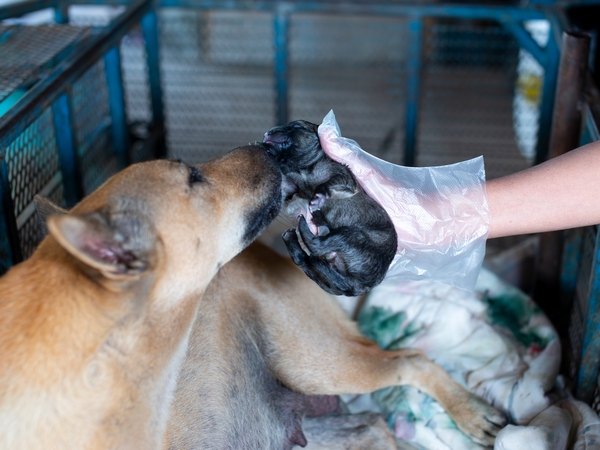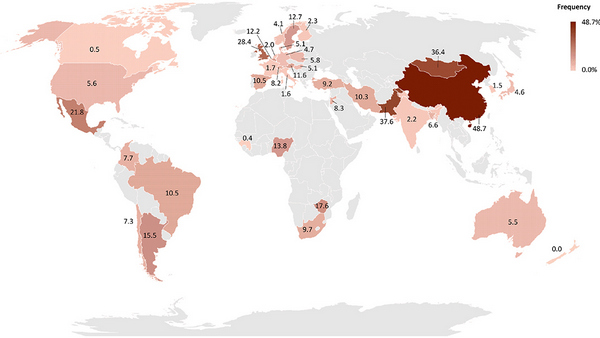Brucellosis in dogs: What is Brucella canis?
What is brucellosis in dogs?
Brucellosis, often referred to as Brucella canis, is a bacterial disease that affects all dogs regardless of age or breed, although dogs who haven't been spayed or neutered and are used for breeding are most at risk. It can also be passed on to humans. Historically, the UK has not had cases of Brucella canis, but there's been a growing trend of cases associated with imported dogs.
Brucellosis causes, amongst other things, infections in the uterus of female dogs, and an infection in the testicles in male dogs, called epididymitis.
What causes brucellosis in dogs?
Brucellosis in dogs is caused by the bacteria Brucella canis. This bacteria was first discovered in the mid-1960s after an investigation into miscarriages of pregnant beagles. It can also spread to cattle, sheep and humans.
Brucellosis symptoms in dogs
In dogs, infection with Brucella canis might not always lead to clear clinical signs. In some cases, it can cause a variety of symptoms that vary in severity. Because brucellosis affects the reproductive organs, male and female dogs have different symptoms.
In female dogs, the most common signs of brucellosis infection are:
- Stillbirths
- Late miscarriages
- Infertility
- Inflamed uterus
- Giving birth to weak puppies
If your dog has miscarried because of brucellosis, it’s likely there will be discharge from their vagina in the following days and weeks. Unfortunately, this discharge will most likely return during any later pregnancies.
Male dogs show different symptoms. These may be easier to spot than female symptoms as they affect the testicles and can be seen without medical intervention. Their symptoms include:
- Infertility
- Swollen testicles
- Skin rash around the scrotum
Male dogs who have had the infection for a long time without treatment might end up with shrunken testicles. Their testicles may even begin to waste away.
Some symptoms can affect both sexes, and your dog may show some, or none, of these:
- Discospondylitis (inflammation of the spinal discs)
- Tiredness
- Premature ageing
- Swollen lymph nodes
- Back pain
- Difficulty walking
- Eye and kidney infections
How is brucellosis spread in dogs?
Canine brucellosis is mainly spread through close contact with infected breeding dogs. This can occur during mating or when dogs come into contact with infected bodily fluids, such as semen, vaginal discharge, and birthing fluids.
While there are various ways that brucellosis can be transmitted, it's important to note that not all are equally common. For example, transmission through licking infected bodily fluids is possible but less likely compared to direct contact during breeding.
In the UK, most reported cases of Brucella canis have involved dogs that were either directly imported or had significant interactions with imported dogs. This includes dogs that have mated with an imported dog, those that have come into contact with the birthing products of an imported dog, or puppies that are the offspring of an imported dog.
Can humans catch brucellosis from dogs?
Canine brucellosis can spread to humans although this is rare. Vets, pet owners and breeders are most at risk when helping an infected dog give birth, which is why vets must wear effective PPE when treating dogs suspected of having the disease. Brucellosis can also be passed from a family pet to human family members through infected bodily fluids but there have been very few reported cases of this. Certain groups, including children under five, the elderly, and individuals with weakened immune systems, are more vulnerable and may experience more severe symptoms if they contract the disease.
Symptoms of human brucellosis include:
- Fever
- Headaches
- Lower back pain
- Dizziness
- Joint and muscle pain
- Fatigue
- Loss of appetite
Case study
Grandmother Wendy Hayes lost all five of her dogs to brucellosis after fostering a pregnant dog from Belarus.
She also caught the disease herself — which is very rare — soon after Moosha miscarried, losing all 10 of her puppies.
Three of Wendy’s four dog’s later tested positive for brucellosis.
All five dogs were put to sleep to help stop the spread of the disease, leaving Wendy heartbroken.
She’s now calling on the government to ban all imports of dogs until the risks from brucellosis are reduced.

Canine brucellosis treatment
Brucellosis in dogs is very difficult to treat. Antibiotics can control the infection, but no cure or treatment is 100% effective. Sadly, the only certain way to remove the risk of spreading disease caused by Brucella canis, and to prevent suffering, is to put infected dogs to sleep.
Owners who do choose to treat their dogs — which is not recommended — may decide to spay or neuter them, especially if they’re female, as this helps remove the most traumatic symptoms of the disease. Neutering also reduces how much they can 'shed' the bacteria, reducing the chances of passing it on to other dogs. Isolating your infected dog will also help reduce the spread of infection.
The most effective treatment for brucellosis in dogs is a combination of neutering and a lengthy course of antibiotics. But even if you do opt to go down this route, your dog will still need regular blood tests to monitor the infection, and it's important to note that antibiotic treatment may reduce the risk of spreading the infection but may not clear the Brucella canis infection completely. Your vet will be able to guide you through this.
Canine brucellosis prevention
Unless you’re a breeder or plan to have puppies, the best prevention for brucellosis is spaying or neutering your dog. If you do want to breed your dog, you should ensure they’re tested for brucellosis and other diseases.
Brucellosis vaccine for dogs
No vaccine for brucellosis is currently available, and treatment can be long and expensive with no guarantee of success.
How common is brucellosis in dogs?
Brucellosis is rare in the UK and up to early 2021, around 40 cases in dogs had been reported. The vast majority of dogs testing positive are believed to have acquired the infection outside of the UK, but we do not know this for certain. The first dog-to-human case was reported in March 2022, when Wendy Hayes contracted B canis and was hospitalised for two weeks.
How do vets test for brucellosis in dogs?
There are, unfortunately, no tests for brucellosis in dogs that are 100% accurate. Blood samples may not always contain traces of the bacteria, while PCR tests aren’t usually sensitive enough to detect the disease.
In most cases, experts recommend serological testing. These look for antibodies — proteins that can fight off infections — in blood. With brucellosis, these antibodies are usually produced within two weeks of infection but can take up to three months, and sometimes infected puppies may not produce them at all.
Due to the lack of reliable testing methods, your vet will also ask about your dog's symptoms, their recent movements and whether they’ve come into contact with other dogs in recent weeks and months. This comprehensive approach helps in making a more informed diagnosis.
For dogs showing specific clinical signs that raise suspicion of brucellosis, especially those with a history of importation or contact with imported dogs, testing becomes even more crucial. The National Reference Laboratory for Brucella canis recommends the use of two serological tests. A positive result in either test indicates a serologically positive case, while negative results in both tests suggest a serologically negative case.
How much does brucellosis testing cost?
There’s no set price in the UK for brucellosis testing, although you can expect to pay upwards of £100 for the first test.
I’m worried my dog has brucellosis, what should I do?
Speak to your local vet using our find a vet function. Your vet will arrange for testing to be carried out. If your dog tests positive for Brucella canis, by law the case must be reported to the Animal and Plant Health Agency. You should also report the infection to your local health protection team.
In which countries is brucellosis found?
Brucella canis is considered endemic in southern parts of the USA, Mexico, Central America, and South America. Numerous cases have been reported in China, India and Japan, and it’s also found in Canada.

This map shows which countries have reported brucellosis infections by frequency. Regions in grey represent countries with no proper surveys into the disease. Figures accurate as of March 2021. Credit: Renato L. Santos
In Europe, countries with large stray dog populations are believed to have the highest prevalence of the disease. Concerns have been raised about dogs in Romania, Belarus, Russia, Moldova and North Macedonia, among other countries.
Importing puppies to the UK
While the UK has one of the most rigorous pet-checking regimes in the world — and all imported dogs must meet certain health requirements, have the correct documentation and be old enough to travel — it’s currently not compulsory to test for brucellosis.
Unfortunately, thousands of puppies and dogs are imported into the UK illegally every year. Many are bred in appalling conditions and smuggled via long, arduous routes. It is important that dogs from abroad are tested for brucellosis — and other diseases — before travelling to the UK. If you have any concerns about this prior to buying, adopting or rescuing an imported dog, you should consider whether to go ahead.


